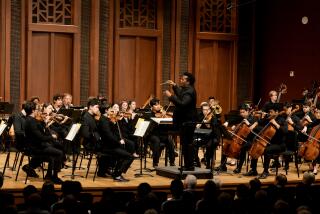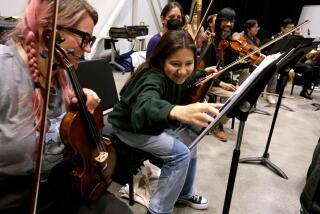A String of Insights
- Share via
To the layman, musical talent can seem a gift bestowed by the gods. But a musician knows that music means an infinite amount of work.
A master class gives people who might not otherwise observe the process a chance to see the kind of work that’s involved. That’s what happened when famed cellist Janos Starker, 74, worked with Carter Dewberry, 23, on Schumann’s Cello Concerto in Founders Hall at the Orange County Performing Arts Center.
Dewberry is principal cellist of the Pacific Symphony Institute at Cal State Fullerton. Starker, who has taught at Indiana University for more than 40 years, among other institutions, is among the most highly regarded cellists of the post-World War II era and was the soloist this week in Dvorak’s Cello Concerto with the Pacific Symphony.
“I’m not conducting a master class,” Starker told the audience of about 100 at the beginning of Tuesday’s class, which was opened to the public. “That’s where an old master, when a young master plays, says, ‘I like my way better.’ I don’t think that’s productive.
“Most of the time, what I like to do is to give information about various aspects of the music,” he said. “There are various ways to play something, although there are certain laws.”
Those laws begin with technical matters, but they have musical results.
How does the musician sit? How does she balance the cello against her knees? How does she draw her bow arm? Does she allow the bow to meander around the string? How does she place her fingers on the strings? How does she move from one note to another? . . .
“There’s a lot to decide,” Starker said.
Sitting is important, he said, “because you caress--embrace--the cello.”
The weight of the body, he said, must be free to flow in an unbroken line from the shoulders down to the point where you touch the instrument. There should be no break at the wrist.
Did such comments make a difference to Dewberry’s playing? Absolutely.
Every technical point Starker made created an instant improvement in her already accomplished musicianship.
Later, responding to questions from the audience, Starker said the musicians who most influenced him were conductor Fritz Reiner, violinist Jascha Heifetz, soprano Maria Callas and tenor Jussi Borling.
Asked about cellist Jacqueline DuPre, whose life has been portrayed in the recent controversial film “Hilary and Jackie,” Starker said he never heard her play live but once heard one of her recordings on the radio.
“I thought, ‘This is a person who doesn’t have long to live,” he said sadly. “It was all tension, tension, tension, without any release. . . . Music must be tension and release. It cannot just be tension.”
Privately, Starker told a reporter, “I’m as bullish [about the future of music] as any stockbroker when the market moves up.
“There are some aspects of it that I’m not cheerful about, because it’s also a question of supply and demand,” he said. “There are more musicians running around today, but the size of the audience is still the same. The supply has so incredibly overshot the goal because they forgot to expand the kind of effort to raise music education as such, music appreciation. What’s necessary is people to listen.”
Still, playing standards has risen dramatically because of music education. “One used to say that someone plays like a mess, but what a great artist! But that doesn’t work anymore. Well, in some instances, it still does. If somebody has an enormously appealing personality, charisma, temperament, that person can get away with all kinds of things, even today.”
Conversely, even though musical proficiency may be at an all-time high, that doesn’t mean there are more genuinely great artists today.
“The general standard of playing is up so high that the people wonder if somebody plays so well, how come [the music] doesn’t send me?” Starker said.
“But I say God is not a democratic institution,” he added. “He distributes talent unevenly. The fact is never in any era are there more than a handful of great artists.”
More to Read
The biggest entertainment stories
Get our big stories about Hollywood, film, television, music, arts, culture and more right in your inbox as soon as they publish.
You may occasionally receive promotional content from the Los Angeles Times.










